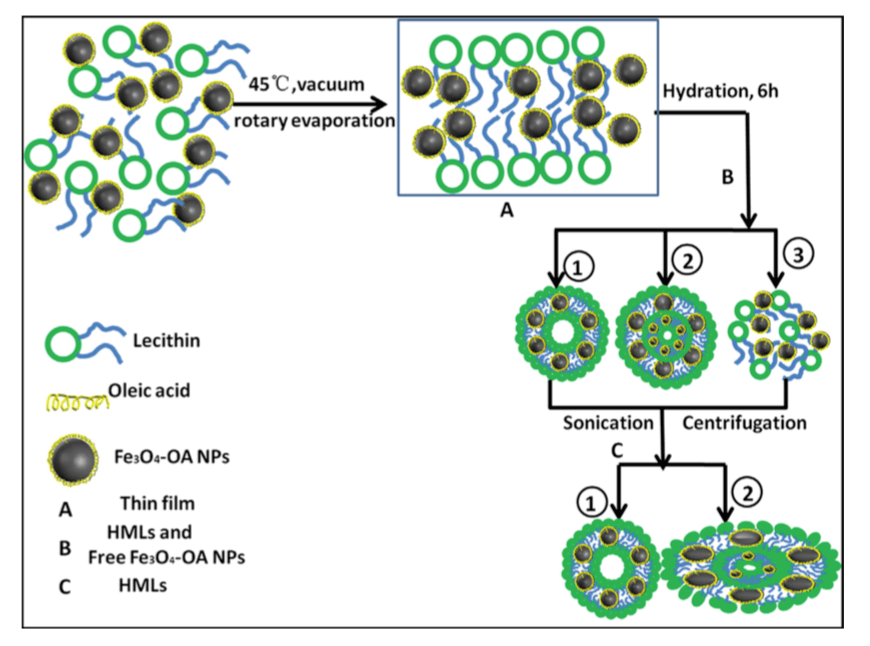Mempro™ Liposome Preparation by Film Method
Creative Biostructure, as a leader and pioneer in liposome research and development, has established a cutting-edge Mempro™ Liposome platform to provide liposome preparation services by various mechanical or non-mechanical methods.
 Figure 1. Functional liposomes for MR imaging were prepared by the thin film dispersing method, embedding with the hydrophobic magnetic nanoparticle. (L. Han and X. Zhou, 2016)
Figure 1. Functional liposomes for MR imaging were prepared by the thin film dispersing method, embedding with the hydrophobic magnetic nanoparticle. (L. Han and X. Zhou, 2016)
Thin-film method is one of the most applied traditional methods for liposome preparation. Mechanical agitations such as shaking, swirling, and pipetting lead to the break of the thin lipid tubules and resealing of the exposed hydrophobic edges, resulting in the formation of liposomes. As to smaller and less lamellar liposome preparation systems, additional energy is needed. When we prepared liposomes with mixed lipid composition, the lipids have to be dissolved first and then mixed in an organic solvent to assure a homogeneous mixture of lipids. After the lipids are mixed thoroughly, the solvent can be removed to yield a lipid film. To totally get rid of the residual organic solvent, we can use vacuum drying.
By adding an aqueous medium into the container of dry lipid, Creative Biostructure can simply achieve the hydration of the dry lipid film with agitation. The lipid suspension has to be maintained above the critical temperature (Tc) during the hydration process after addition of the hydrating medium. Spinning the round bottom flask of the lipid suspension maintained at a temperature above the Tc with warm water bath allows the lipid to hydrate in its fluid phase with adequate agitation.
Creative Biostructure found that the sizing process can be made easier by allowing the vesicle suspension to stand overnight prior to downsizing, which also improves the homogeneity of the size distribution. Generally, the hydration medium is determined by the application of the lipid vesicles. Our hydration products are multilamellar large vesicle (MLV) analogous, with each lipid bilayer separated by a water layer. We should avoid to add methanol into the preparation systems if not necessary since methanol is quite difficult to remove and can form hydrogen bonds with polar head groups. A stable, hydrated MLV suspension can be downsized by a variety of techniques such as sonication and extrusion.
Key factors:
- lipid composition,
- the organic solvent;
- the composition of the aqueous phase;
- the rapidity of evaporation;
- the power of agitation.
Mempro™ Liposome Technology provides a full package of liposome preparation services. Our rich-experienced technical managers and service representatives can assist you to optimize your custom projects. Creative Biostructure aims to be your reliable research associate, please feel free to contact us for a detailed quote.
References:
L. Han and X. Zhou. (2016). Synthesis and characterization of liposomes nano-composite-particles with hydrophobic magnetite as a MRI probe. Applied Surface Science, 376: 252-260.
J. S. Dua, et al. (2012). Liposome: method of preparation and application. International Journal of Pharmaceutical Studies and Research, 3: 2229.
A. Akbarzadeh, et al. (2013). Liposome: classification, preparation, and applications. Nanoscale Research Letters, 8: 102.
